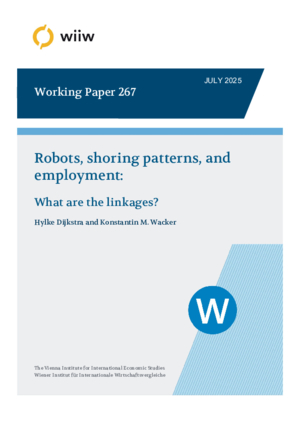Robots, shoring patterns, and employment: What are the linkages?
Hylke Dijkstra and Konstantin M. Wacker
wiiw Working Paper No. 267, July 2025
34 pages including 6 Tables and 5 Figures
In this paper, we analyse how robotisation is associated with industry output and its production inputs. We therefore link data on employment, robotisation and input-output relations for 15 manufacturing industries across 35 countries. Analysing the decade prior to 2018, we show that robotising industries experience increases in output and approximately equiproportional increases in value added, employment, domestic intermediate inputs and foreign intermediate inputs. Owing to this equiproportionality, robotising industries do not see a significant change in their domestic input ratios (value added plus domestic intermediates relative to total inputs).
Our empirical results document that robotising industries are thriving in terms of output generation, that those thriving industries are internationally well integrated, and that their output expansion is associated with employment generation. Industries that use an increasing share of domestic production inputs generally experience less favourable output and employment developments, although this association is imprecisely estimated.
Keywords: Robots, reshoring, employment, labour, production location, global value chains, GVCs
JEL classification: E23; J23; O30
Countries covered: Austria, Belgium, Bulgaria, Chile, China, Colombia, Czechia, Denmark, Estonia, Finland, France, Germany, Greece, Hungary, Iceland, Ireland, Italy, Japan, Latvia, Lithuania, Malta, Netherlands, Norway, Poland, Portugal, Romania, Slovakia, Slovenia, South Korea, Spain, Sweden, Switzerland, Turkey, United Kingdom, US
Research Areas: Labour, Migration and Income Distribution, International Trade, Competitiveness and FDI
